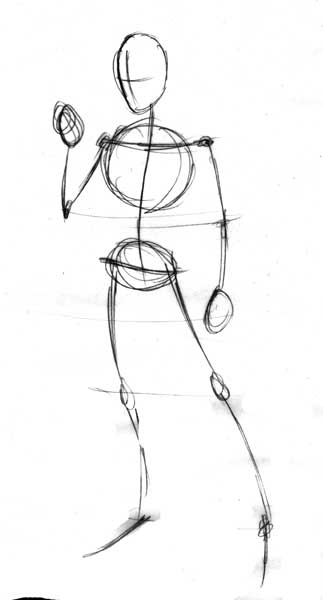Hi, I'm Radium and I'm an everything critic (ignore my sig, I actually can draw well). I read people's stories, look at people's art, and watch people's animations, and then tell them everything they did wrong and how to fix it. Also, I can fly and shoot lasers out of my eyes and turn invisible.
Anyway!
You're not off to a bad start at all, stylistically; studying other people's art was probably a good move. The first design has a nice amount of personality and the facial structure is pretty good - especially since you look to be easily able to draw it from both a front and 3/4 view.
Something to keep note of, though, is where the neck attaches to the head. A lot of beginning artists seem to have problems with this. Necks attach towards the back of the head, not right in the center. Look at this random side-view picture off Google, for example:

The back of the guy's head flows right into his neck while in front his jaw sticks out, and the "hinge" of the jaw is about in the middle of his neck. In both your pictures, you place the character's chin directly over their neck and have their jaw hinge back behind their neck entirely.
Below the head, the drawing gets a lot less structured and more rigid looking, mainly due to strange proportions. A lot of artists will plot out a drawing first with a rough stick figure or lightly sketch the character with some basic shapes before darkening it in to help get the anatomy right. This can also help you make poses much more interesting and have a lot more overall personality; look at this example of what I mean from
PolyKarbon's male figure tutorial:

The "forward leaning" stature in this example makes the character look much more loose and animated, as though you can easily imagine them moving.
It also demonstrates something else you need to keep in mind: arm length. Human (and I guess bipedal hare) arms, if at the character's side, reach down to just below their hips (see above stick figure). If Reginald's arms were at his side, they'd go all the way down to his knees, meaning they look too long.
Oh, and a more minor criticism about the first picture: I presume the face where he's saying "I told you to never call me fluffy" is supposed to look angry, and gritted teeth are a good way to go. However, the side of his mouth is too high, making his expression very smile-like.
In both pictures, you're having trouble drawing feet. You've given them a kind of foot shape, but they're still flat looking and sometimes different sizes. Like I said, constructing drawings out with basic shapes and lines ahead of time can help a lot.
Here's a drawing where someone broke a foot into thee basic shapes, showing a good way to do it.
However, something else you might want to consider is doing some random observational practice. Try drawing your own foot, even if it's just a quick sketch on a notebook margin. Learning to copy contours and shapes of objects by looking at them (or, later, imagining them) improves drawing an unbelievable amount.
On the last picture, something I want to point out is that drawing lumpy looking lines on a character's arms does not pass as muscles. Rather, it's more important to focus on the shape the muscles give to the body; even though you drew in some lines to suggest Blook had muscles, his limbs are just as tube-shaped as Fluffykins'.
It takes a while to get used to where muscles are, but the main thing you should probably pay attention to at this point is where they make limbs get thinner and thicker.
This sketch shows most of the important muscles pretty well, and how they wrap around each other. The important things to understand about muscles is (1) that they weave around one another in specific ways and (2) they move limbs by pulling, so when an arm is bent - especially lifting something heavy - they'll bulge a bit more. If you want to know a bit about how muscles specifically pertain to cartooning I highly recommend the book "Action! Cartooning" (Google it if you want more info) as it specifically talks about how to simplify the portrayal of muscles and stuff so it doesn't look more complicated than the rest of the drawing.
Anyway, the only other thing I have to say is that you should try experimenting with other, more complicated poses. They can be a lot more fun than front views and you'll learn a lot from it. Good luck with learning to draw and I look forward to (criticizing) the next batch.